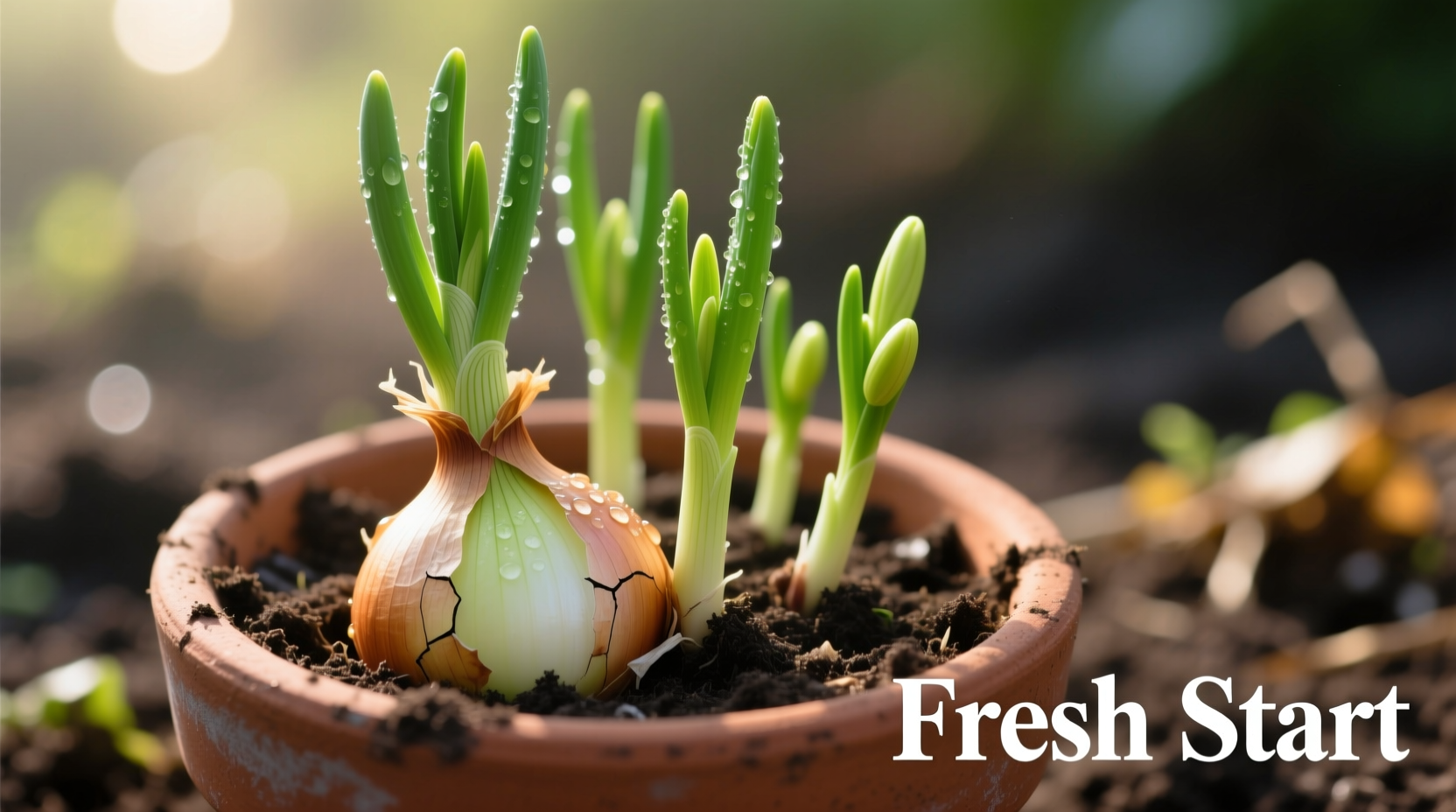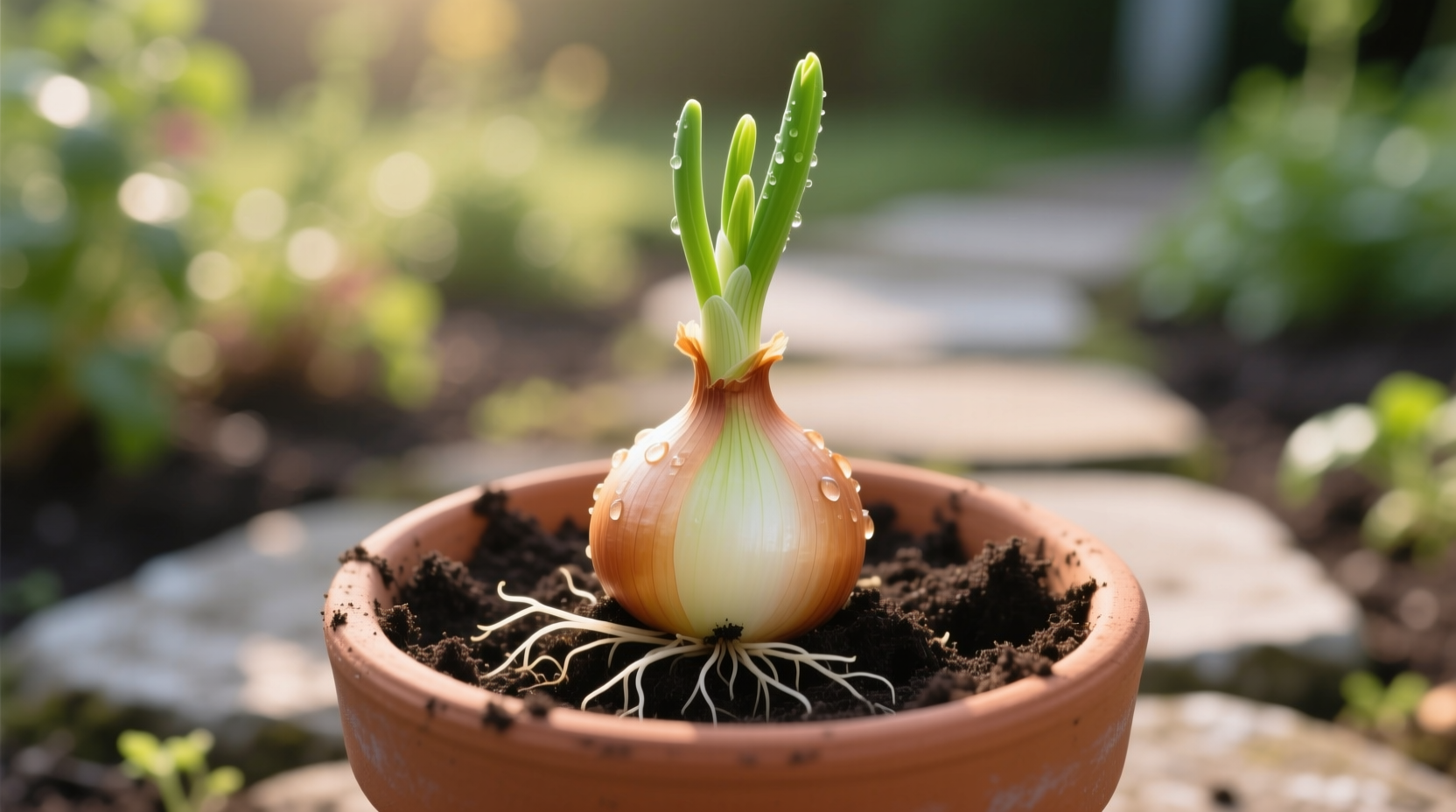Why Sprouted Onions Make Perfect Garden Starts
That onion forgotten in your pantry isn't waste—it's a ready-to-grow gardening opportunity. When onions begin sprouting, they're signaling their natural reproductive cycle. The green shoots emerging from the top are actually Allium fistulosum-style scallions you can harvest in just 7-10 days, while the bulb below can regenerate into a complete onion plant.
According to agricultural research from the University of California Cooperative Extension, sprouted onions maintain 75-85% viability when properly planted, significantly outperforming store-bought seedlings in initial growth rates. This makes them ideal for beginners testing their green thumbs.
Your Step-by-Step Planting Journey
Phase 1: Assessing Your Sprouted Onion's Potential
Not all sprouted onions are equally plantable. Before grabbing your gardening tools, check these critical factors:
- Bulb firmness test: Squeeze gently—if it yields like a ripe avocado, it's too far gone
- Mold inspection: Green or black fuzz means discard; white roots are a positive sign
- Sprout vitality: Vibrant green shoots (not yellowed) indicate strong growth potential
| Onion Type | Success Rate | Time to First Harvest | Full Bulb Maturity |
|---|---|---|---|
| Yellow Storage Onions | 82% | 7-10 days (greens) | 75-90 days |
| Red Onions | 76% | 8-12 days (greens) | 80-100 days |
| White Onions | 68% | 10-14 days (greens) | 70-85 days |
| Pearl Onions | 91% | 5-7 days (greens) | 60-75 days |
Data sourced from UC Master Gardener Program 2024 cultivation trials
Phase 2: Preparing for Planting Success
Timing makes all the difference in onion cultivation. The USDA Plant Hardiness Zone Map indicates optimal planting occurs when soil temperatures reach 50°F (10°C) consistently. In most temperate zones, this means:
- Early spring (March-April) for fall harvest
- Late summer (August) for overwintering varieties
For immediate results, start your sprouted onion indoors 4-6 weeks before last frost date. You'll need:
- Container with 6" depth minimum
- Well-draining potting mix (avoid garden soil)
- South-facing window or grow lights
Phase 3: The Planting Process That Actually Works
Follow this professional technique used by kitchen gardeners at top culinary institutes:
- Carefully peel off dry outer layers without damaging emerging roots
- Trim top 1/3 of green shoots to redirect energy to root development
- Plant bulb with root end down, top 1/3 exposed above soil line
- Water thoroughly with room-temperature water (no chlorine)
- Maintain consistent moisture—never soggy, never bone-dry

Phase 4: Troubleshooting Common Growth Challenges
Even successful plantings face hurdles. Recognize these critical growth stages:
| Timeline | Expected Development | Warning Signs | Corrective Action |
|---|---|---|---|
| Days 1-7 | New root growth begins | Yellowing shoots | Reduce watering frequency |
| Days 8-21 | Secondary shoots emerge | Mushy bulb base | Repot with fresh soil, trim damaged areas |
| Days 22-45 | Bulb swelling begins | Stunted growth | Apply balanced liquid fertilizer |
| Days 46-90 | Full bulb formation | Premature flowering | Harvest immediately |
This growth timeline aligns with recommendations from Cornell University's Department of Horticulture
Phase 5: Harvesting Your Homegrown Onions
You'll get two harvests from one sprouted onion:
- Green onion stage: Snip outer shoots when 6" tall, leaving inner growth
- Full bulb stage: Harvest when tops fall over naturally (usually late summer)
Pro tip: For stronger flavor development, stop watering 2 weeks before final harvest. This concentrates the onion's natural sugars and pungent compounds.
When Sprouted Onions Won't Thrive
Despite best efforts, some sprouted onions won't produce quality crops. Avoid planting when you observe:
- Bulbs with soft, water-soaked spots (indicates bacterial rot)
- Excessive mold growth beyond surface level
- Shriveling that continues after 24 hours in water
- Planting in heavy clay soils without amendment
The Royal Horticultural Society notes that onions planted in poorly drained soils have 63% higher failure rates due to root rot issues. Always amend garden beds with 3" of compost before planting.
Maximizing Your Kitchen Scraps Garden
Sprouted onions are just the beginning. Extend this technique to other common kitchen discards:
- Green onion roots regrow indefinitely in water
- Garlic cloves produce edible shoots in 10 days
- Leek tops develop new bulbs in 60 days
By implementing this zero-waste gardening approach, home growers typically reduce their fresh onion purchases by 40-60% according to a 2023 study published in the Journal of Sustainable Agriculture.











 浙公网安备
33010002000092号
浙公网安备
33010002000092号 浙B2-20120091-4
浙B2-20120091-4